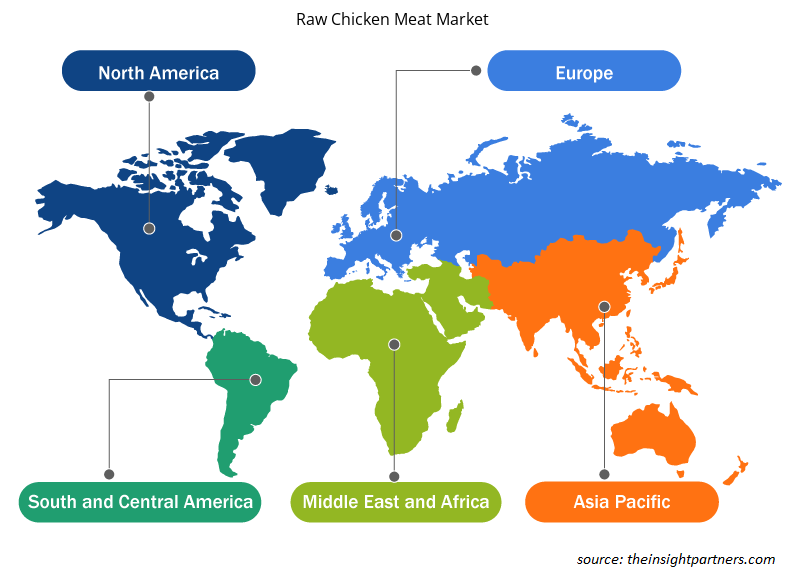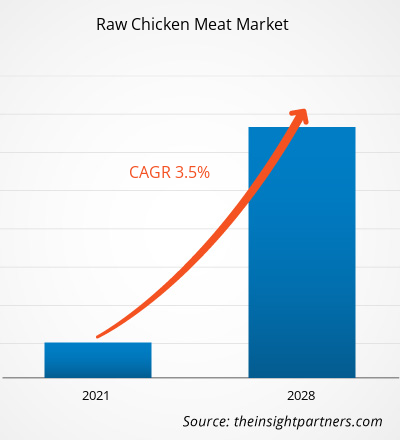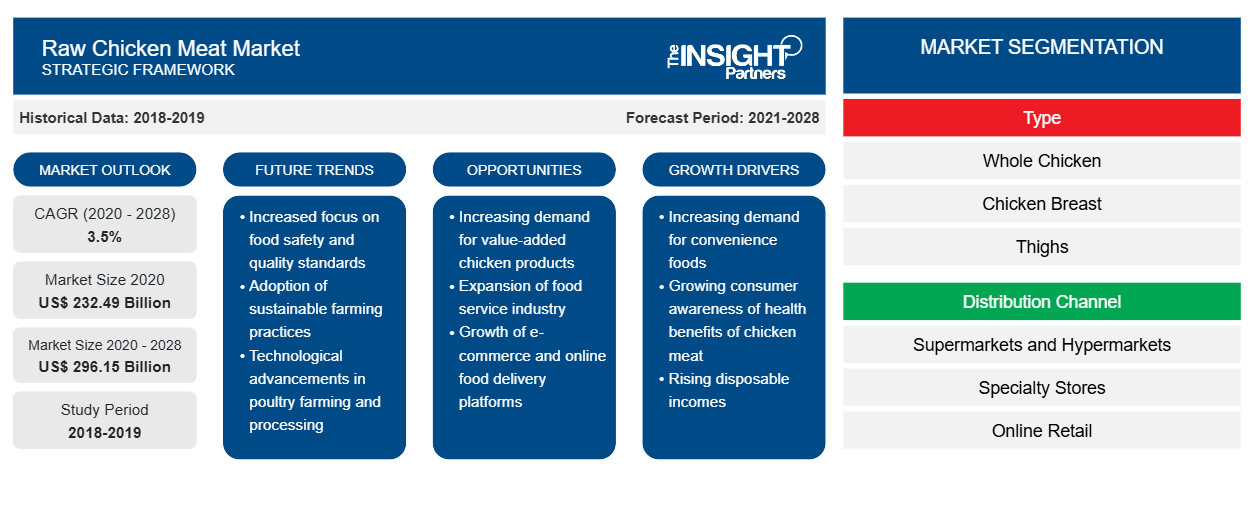Der Markt für rohes Hühnerfleisch soll von 232.489,41 Millionen US-Dollar im Jahr 2021 auf 296.150,51 Millionen US-Dollar im Jahr 2028 anwachsen; von 2021 bis 2028 wird mit einer durchschnittlichen jährlichen Wachstumsrate von 3,5 % gerechnet.
Hühnerfleisch ist unverzichtbar, da es in vielen Ländern eine der wichtigsten Proteinquellen für Verbraucher ist. Darüber hinaus haben tierische Lebensmittel einen Proteinverdaulichkeits-korrigierten Aminosäurenwert (PDCAAS) von eins oder knapp darunter. Hühnerfleisch ist leicht verdaulich und die preisgünstigste magere Proteinoption; außerdem enthält Hühnerprotein alle neun essentiellen Aminosäuren. Daher ist die steigende Vorliebe der Verbraucher für proteinreiche Lebensmittel der Schlüsselfaktor, der das Wachstum des Marktes für rohes Hühnerfleisch vorantreibt.
Der asiatisch-pazifische Raum hatte im Jahr 2020 den größten Anteil am weltweiten Markt für rohes Hühnerfleisch. Der Markt in dieser Region wird im Prognosezeitraum voraussichtlich ein bemerkenswertes Wachstum verzeichnen, und das prognostizierte Wachstum ist hauptsächlich auf die schnell wachsende Bevölkerung, die bedeutende wirtschaftliche Entwicklung, den Anstieg der Kaufkraft der Menschen und das Wachstum der Lebensmittel- und Getränkeindustrie zurückzuführen. Der asiatisch-pazifische Raum ist aufgrund der hohen Nachfrage nach diesen Produkten einer der lukrativsten Märkte für die Hersteller von rohem Hühnerfleisch. Infolgedessen bieten Hersteller Produkte wie Fleisch zu erschwinglichen Preisen an.
Passen Sie diesen Bericht Ihren Anforderungen an
Sie erhalten kostenlos individuelle Anpassungen an jedem Bericht, einschließlich Teilen dieses Berichts oder einer Analyse auf Länderebene, eines Excel-Datenpakets sowie tolle Angebote und Rabatte für Start-ups und Universitäten.
-
Holen Sie sich die wichtigsten Markttrends aus diesem Bericht.Dieses KOSTENLOSE Beispiel umfasst eine Datenanalyse von Markttrends bis hin zu Schätzungen und Prognosen.
Auswirkungen der COVID-19-Pandemie auf den Markt für rohes Hühnerfleisch
Die COVID-19-Pandemie hatte 2020 Auswirkungen auf die Fleischproduktion, die Fleischpreise und die Lieferkette. Die Verhängung von Ausgangssperren, der Abbau von Arbeitskräften, Transportbeschränkungen und Änderungen der Gesetzgebung für lokale und globale Exporte führten zu neuen Herausforderungen bei der Produktion und Verarbeitung von rohem Hühnerfleisch. Am schlimmsten betroffen war die Geflügelindustrie, in der 1,5 Millionen Kleinbauern beschäftigt sind. Laut Frontiers Media SA begannen im April 2020 Fleischverpackungsanlagen aufgrund der beschleunigten Verbreitung von SARS-CoV-2 unter den Arbeitern zu schließen. Darüber hinaus entfallen laut East Asia Forum etwa 25 % des weltweiten Fleischkonsums auf China. Der Zusammenhang mit dem Ursprung des Virus hat jedoch die Nachfrage nach Lebensmitteln tierischen Ursprungs in China gestört. Die Verbraucher haben ihre Lebensmittelrechnungen gekürzt, während die Versorgungssysteme gestört wurden. Aufgrund der COVID-19-Pandemie vermeiden die Menschen außerdem den Verzehr von Fleischprodukten in Restaurants außerhalb. Die Nachfrage nach Hühnerfleisch könnte jedoch in den kommenden Jahren mit einem Anstieg des Durchschnittseinkommens und der städtischen Bevölkerung steigen, was im Laufe der Jahre zu einem stetigen Anstieg des Konsums führen wird.
Amick Farms; Foster Farms; JBS SA; Koch Foods; Mountaire Farms; Perdue Farms; PILGRIM'S; Sanderson Farms; Tyson Foods, Inc.; und Wayne Farms LLC gehören zu den etablierten Akteuren auf dem globalen Markt für rohes Hühnerfleisch. Die Marktteilnehmer verfolgen Strategien wie Produktentwicklungen, Werkserweiterungen sowie Fusionen und Übernahmen, um ihre Präsenz weltweit auszubauen und die wachsende Nachfrage der Endverbraucher zu decken. So begann beispielsweise Seara, eine Tochtergesellschaft der JBS-Gruppe, im Mai 2021 mit dem Export von Schweine- und Geflügelprotein nach Kambodscha und in die Dominikanische Republik. JBS exportiert mittlerweile proteinreiche Lebensmittel in über 150 Länder weltweit.
Markteinblicke
Steigendes Bewusstsein der Verbraucher über die Vorteile des Verzehrs proteinreicher Lebensmittel
Da die Gesundheit immer mehr im Mittelpunkt steht, sind die Verbraucher auf gesunde Lebensmittel mit einem reichhaltigen Nährwertprofil umgestiegen, insbesondere auf Proteine. Proteine sind die Bausteine des Körpers, die seine Struktur und Funktionen aufrechterhalten. Aminosäuren, die Monomere in Proteinen, wirken als Coenzyme oder Cofaktoren in vielen biochemischen Prozessen im menschlichen Körper. Der Körper verwendet Aminosäuren auch zum Aufbau und zur Reparatur von Muskeln und Knochen sowie zur Herstellung von Enzymen und Hormonen. Der Verzehr von Proteinen fördert das richtige Wachstum und die Entwicklung bei Kindern und Jugendlichen. Menschen, die mehr Proteine zu sich nehmen, neigen dazu, ihre Knochenmasse besser zu erhalten und haben ein viel geringeres Risiko für Knochenbrüche und Osteoporose. Der Anstieg des Verzehrs proteinreicher Lebensmittel treibt also das Wachstum des Marktes für rohes Hühnerfleisch an.
Typ-Einblicke
Je nach Art ist der Markt für rohes Hühnerfleisch in ganzes Huhn, Hühnerbrust, Hühnerschenkel, Hühnerkeulen, Hühnerflügel und Sonstiges unterteilt.Das Hähnchenbrustsegment hatte im Jahr 2020 den größten Marktanteil und wird im Prognosezeitraum voraussichtlich die höchste durchschnittliche jährliche Wachstumsrate (CAGR) auf dem Markt verzeichnen. Das Hähnchenbrustsegment wird im Prognosezeitraum voraussichtlich den größten Umsatzanteil auf dem Markt haben. Hähnchenbrust ist eine Art weißes Fleisch, das aus dem Brustmuskel des Huhns gewonnen wird. Es hat einen geringen Fett- und einen hohen Proteingehalt. Hähnchenbrust wird normalerweise ohne Haut und Knochen verkauft, da sich das meiste Hühnerfett in der Haut konzentriert. Das US-Landwirtschaftsministerium (USDA) gibt an, dass die durchschnittliche Portionsgröße von 4 Unzen roher, knochenloser und hautloser Hähnchenbrust etwa 110 Kalorien, 26 Gramm Protein, 1 Gramm Fett, 75 Milligramm Cholesterin und 85 Milligramm Natrium enthält. Der Nährwert und die Kalorienzahl einer einzelnen Hähnchenbrust variieren je nach Größe. Darüber hinaus hängt es auch davon ab, ob das Huhn auf der Weide, in Freilandhaltung, in Käfigen oder in Käfigen aufgezogen wurde. Hähnchenbrust ist außerdem eine gute Vitaminquelle wie Vitamin B, Vitamin D, Kalzium, Eisen und Zink. Die wachsende Vorliebe für weißes Fleisch treibt vor allem die weltweite Nachfrage nach Hähnchenbrust an. Darüber hinaus kann Hähnchenbrust bequem zu Hause zubereitet werden, was zu ihrer weltweiten Beliebtheit beiträgt.
Einblicke in Vertriebskanäle
Basierend auf den Vertriebskanälen ist der Markt für rohes Hühnerfleisch in Supermärkte und Hypermärkte, Fachgeschäfte, Online-Einzelhandel und andere unterteilt. Das Segment der Fachgeschäfte hatte im Jahr 2020 den größten Marktanteil, und das Segment der Supermärkte und Hypermärkte wird im Prognosezeitraum voraussichtlich die höchste durchschnittliche jährliche Wachstumsrate auf dem Markt verzeichnen. Fachgeschäfte konzentrieren sich auf bestimmte Produktkategorien und verfügen über ein breites Produktsortiment. Diese Geschäfte bieten ein personalisiertes Einkaufserlebnis und bieten ihren Kunden Produkte mit Mehrwert. Darüber hinaus verfügen diese Arten von Geschäften in der Regel über geschultes Personal, das sich mit den angebotenen Produkten auskennt. Verbraucher kaufen rohes Hühnerfleisch lieber in Fachgeschäften, um die Frische und Sicherheit des Produkts sicherzustellen. Sie bestellen gekochtes Hühnerfleisch möglicherweise lieber über Online-Kanäle; sie neigen jedoch dazu, Hühnerfleischgeschäfte aufzusuchen, um rohes Hühnerfleisch zu kaufen.
Zu den auf dem Markt für rohes Hühnerfleisch tätigen Akteuren gehören unter anderem Amick Farms, Foster Farms, JBS SA, Koch Foods, Mountaire Farms, Perdue Farms, PILGRIM’S, Sanderson Farms, Tyson Foods, Inc. und Wayne Farms LLC.
Regionale Einblicke in den Markt für rohes Hühnerfleisch
Die regionalen Trends und Faktoren, die den Markt für rohes Hühnerfleisch während des Prognosezeitraums beeinflussen, wurden von den Analysten von Insight Partners ausführlich erläutert. In diesem Abschnitt werden auch die Marktsegmente und die Geografie von rohem Hühnerfleisch in Nordamerika, Europa, im asiatisch-pazifischen Raum, im Nahen Osten und Afrika sowie in Süd- und Mittelamerika erörtert.

- Erhalten Sie regionale Daten zum Markt für rohes Hühnerfleisch
Umfang des Marktberichts über rohes Hühnerfleisch
| Berichtsattribut | Details |
|---|---|
| Marktgröße im Jahr 2020 | 232,49 Milliarden US-Dollar |
| Marktgröße bis 2028 | 296,15 Milliarden US-Dollar |
| Globale CAGR (2020 - 2028) | 3,5 % |
| Historische Daten | 2018-2019 |
| Prognosezeitraum | 2021-2028 |
| Abgedeckte Segmente |
Nach Typ
|
| Abgedeckte Regionen und Länder |
Nordamerika
|
| Marktführer und wichtige Unternehmensprofile |
|
Dichte der Marktteilnehmer für rohes Hühnerfleisch: Die Auswirkungen auf die Geschäftsdynamik verstehen
Der Markt für rohes Hühnerfleisch wächst rasant, angetrieben durch die steigende Nachfrage der Endverbraucher aufgrund von Faktoren wie sich entwickelnden Verbraucherpräferenzen, technologischen Fortschritten und einem größeren Bewusstsein für die Vorteile des Produkts. Mit steigender Nachfrage erweitern Unternehmen ihr Angebot, entwickeln Innovationen, um die Bedürfnisse der Verbraucher zu erfüllen, und nutzen neue Trends, was das Marktwachstum weiter ankurbelt.
Die Marktteilnehmerdichte bezieht sich auf die Verteilung der Firmen oder Unternehmen, die in einem bestimmten Markt oder einer bestimmten Branche tätig sind. Sie gibt an, wie viele Wettbewerber (Marktteilnehmer) in einem bestimmten Marktraum im Verhältnis zu seiner Größe oder seinem gesamten Marktwert präsent sind.
Die wichtigsten auf dem Markt für rohes Hühnerfleisch tätigen Unternehmen sind:
- Amick Farms
- Pflegefarmen
- JBS (Primo-Metzgerei)
- Koch Foods
- Mountaire-Farmen
Haftungsausschluss : Die oben aufgeführten Unternehmen sind nicht in einer bestimmten Reihenfolge aufgeführt.

- Überblick über die wichtigsten Akteure auf dem Markt für rohes Hühnerfleisch
Bericht-Spotlights
- Fortschrittliche Branchentrends auf dem Markt für rohes Hühnerfleisch helfen den Akteuren bei der Entwicklung wirksamer langfristiger Strategien
- Von den Marktteilnehmern verfolgte Geschäftswachstumsstrategien zur Sicherung des Wachstums in entwickelten und sich entwickelnden Märkten
- Quantitative Analyse des Marktes für rohes Hühnerfleisch von 2019 bis 2028
- Schätzung der weltweiten Nachfrage nach rohem Hühnerfleisch
- Porters Fünf-Kräfte-Analyse zur Veranschaulichung der Wirksamkeit der in der Branche tätigen Käufer und Lieferanten
- Aktuelle Entwicklungen zum Verständnis des wettbewerbsorientierten Marktszenarios
- Markttrends und -aussichten sowie Faktoren, die das Wachstum des Marktes für rohes Hühnerfleisch vorantreiben und bremsen
- Unterstützung im Entscheidungsprozess durch Aufzeigen von Marktstrategien, die das kommerzielle Interesse untermauern und zum Marktwachstum führen
- Detaillierte Übersicht und Segmentierung des Marktes sowie der Dynamik der Rohhühnerfleischindustrie
- Größe des Marktes für rohes Hühnerfleisch in verschiedenen Regionen mit vielversprechenden Wachstumschancen
Markt für rohes Hühnerfleisch – nach Typ
- Ganzes Huhn
- Hühnerbrust
- Schenkel
- Trommelstock
- Flügel
- Sonstiges
Markt für rohes Hühnerfleisch – nach Vertriebskanal
- Supermärkte und Hypermärkte
- Fachgeschäfte
- Online-Einzelhandel
- Sonstiges
Firmenprofile
- Amick Farms
- Pflegefarmen
- JBS SA
- Koch Foods
- Mountaire-Farmen
- Perdue-Farmen
- PILGER
- Sanderson Farms
- Tyson Foods, Inc.
- Wayne Farms LLC
- Historische Analyse (2 Jahre), Basisjahr, Prognose (7 Jahre) mit CAGR
- PEST- und SWOT-Analyse
- Marktgröße Wert/Volumen – Global, Regional, Land
- Branchen- und Wettbewerbslandschaft
- Excel-Datensatz
Aktuelle Berichte
Verwandte Berichte
Erfahrungsberichte
Grund zum Kauf
- Fundierte Entscheidungsfindung
- Marktdynamik verstehen
- Wettbewerbsanalyse
- Kundeneinblicke
- Marktprognosen
- Risikominimierung
- Strategische Planung
- Investitionsbegründung
- Identifizierung neuer Märkte
- Verbesserung von Marketingstrategien
- Steigerung der Betriebseffizienz
- Anpassung an regulatorische Trends























 Kostenlose Probe anfordern für - Markt für rohes Hühnerfleisch
Kostenlose Probe anfordern für - Markt für rohes Hühnerfleisch